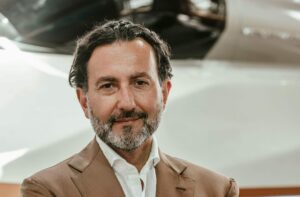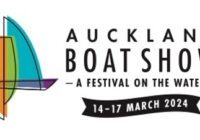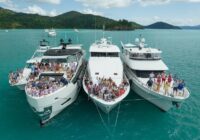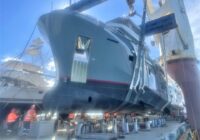E1 has made a ‘flying’ start to 2023, with the announcement of tennis legend Rafael Nadal owning a team, as well as McLaren Applied coming on board as a technical partner.
With racing set to get underway later this year, E1 Co-Founder & CEO Rodi Basso provides exclusive insight into how things are progressing with setting up the world’s first all-electric raceboat championship.
The former Formula 1 engineer, and the brains behind the concept of E1, sat down to discuss the production timeline of the RaceBirds and how the calendar will take shape for the first season.

E1 has had a fast start to 2023 with the Nadal and McLaren announcements. Can you sum up how you feel going into this year?
It has indeed been a fast and super exciting start to the year for E1. Both the Nadal and McLaren announcements have given us a huge boost of energy and it provides the championship with an incredible springboard on which to build on.
Talking specifically about the two recent announcements, can you provide us with some background about why Nadal and McLaren have come on board?
They both joined E1 for different reasons, which is pleasing because it goes to show the strength of our value proposition and the broad range of touchpoints we have across sport, sustainability, and technology. From the Nadal side, speaking with him and his team, it was clear how important sustainability and making a positive impact is in local communities. He’s passionate about the ocean and sees E1 as a platform to help protect marine ecosystems. McLaren’s involvement is slightly different and is linked to their contribution from a technology standpoint. They’re expanding their portfolio into new marine applications and E1 is now the go-to destination. The team at McLaren recognises what we’re trying to achieve from both a technology and engineering perspective, and having them come on board helps position E1 at the top level of high-speed sports.
The focus for the first season will be to host races in the Middle East and Europe, and then expanding out further to North America and Asia in Season 2.
The E1 grid is also starting to take shape. You now have three teams with Nadal’s team, Team Mexico with Sergio Perez, and the Venice Racing Team. Can you give people an idea of how many teams you expect to line-up on the grid when racing begins?
There will be a minimum of eight teams on the grid in the first season. We have the option to go up to 12 teams, but we won’t exceed that figure to protect the value of each team. Similar to other sports and racing championships in particular, it’s about finding a sweet spot that promotes competition and creates great racing. But stays at a number that remains financially appealing for teams joining the championship. The number we’ve settled on is based on experience in both Formula E and Extreme E. Along with Nadal and [Sergio] Perez, we’re continuing to receive a lot of interest from other names in the world of sport and entertainment. We’re also speaking to big names you’d normally associate with other categories of motorsport, as well as entrepreneurs who want to have a team that represents a particular area of the world or is linked to a city.
What is the strategy for teams and team owners, because E1 does seem to be attracting some big names?
Of course there’s a strategy behind the decision who to partner with, however, it’s our vision and mission first and foremost that is enabling us to attract high-profile sports personalities like Nadal and Perez. Having a clear purpose matters to people and our purpose is to accelerate electrification in the marine industry. Just like our electric cousins at Formula E and Extreme E have done in the automotive industry, we’re trying to do the same with recreation and leisure boats. Taking this approach with having recognisable team owners, it allows us to dramatically expand our reach and grow E1’s fanbase.
Moving on to the calendar, we’ve seen the boat in the water in Monaco, Venice and Rotterdam for the World Port Days. What locations do you expect to be included on the calendar in the first season?
The plan is to have one set of raceboats available for the first season. With another set ready for the start of the following season. Given we’ll be shipping the RaceBirds and freight around the world to reduce our footprint, it restricts us to racing in two regions of the world in Season 1. The focus for the first season will be to host races in the Middle East and Europe, and then expanding out further to North America and Asia in Season 2. E1 is a World Championship and we’re getting a lot of interest from a number of cities. Some conversations are well advanced and we should be ready to publish the provisional calendar soon.
The direction of travel is really promising and we’re confident we’ll be ready for the start of the first season.
There have been some discussions about having a local hub in different regions. Can you shed some light on this?
For most international racing series, the biggest factor in terms of carbon footprint is the method of transporting freight and equipment around the world. With our E1 operations, we’re actively looking at ways to reduce our footprint from the start. By having a racing hub in different continents, we could massively reduce what would normally need to be shipped globally. By operating out of three or four hubs, and by storing the boats locally, that set of equipment can easily service one region instead of having to cover the entire planet. This is what we’re looking at and we’ve already kicked off conversations with Venice, as well as trying to find a suitable location in Florida, and in Asia. Not only does this approach have environmental benefits but it also has economic benefits both for E1 and the local area, aimed at generating new business.
How’s testing going with the boat? Is the RaceBird performing as expected?
It’s going very well and the performance of the boat is exceeding expectations. All the KPIs have been met and we’ve actually broken the top speed of 50 knots, which was our original target. The team at SeaBird and Victory Marine have been working hard putting more milage on each component and stress testing the boat, which is responding well, particularly on the electronics side. The direction of travel is really promising and we’re confident we’ll be ready for the start of the first season.
What is the latest on the sporting format? Are you still looking at a knockout style similar to Extreme E?
We’re still keen on pursuing the knockout style format. Not only is it exciting, I think it naturally lends itself to the characteristics of racing on water. Head-to-head races and multiple sprint races will offer a continuous dose of adrenaline for fans locally or those following the action on TV. We’re also taking a similar path to Extreme E with teams having mixed gender pilots. This format means each pilot has plenty of time behind the wheel and each can contribute to the success of the team. Races will be in the late-afternoon and there will be more activities happening around the event into the evening. This will allow E1 to become more of a ‘city event’ that appeals to as many people as possible.
When do you think racing will begin? When can fans look forward to seeing the first E1 race?
The first season of the UIM E1 World Championship is set to get underway later this year. We’re not able to disclose when or where just yet, but we will soon! Once the racing begins, we’re targeting a cadence of one race per month through to autumn next year.
For more information visit www.e1series.com









